
Let us draw a line segment RT parallel to SP which intersects extended line segment QP at point T.
Given, PS is the angle bisector of ∠QPR. Therefore,
$\angle QPS = \angle SPR$………………………………..(i)

As per the constructed figure,
$\angle SPR=\angle PRT$(Since, PS||TR)……………(ii)
$\angle QPS = \angle QRT$(Since, PS||TR) …………..(iii)
From the above equations, we get,
$\angle PRT = \angle QTR$
Therefore,
PT=PR
In $\triangle$ QTR, by basic proportionality theorem,
$\dfrac{QS}{SR} = \dfrac{QP}{PT}$
Since, PT=TR
Therefore,
$\dfrac{QS}{SR} = \dfrac{PQ}{PR}$
Hence, proved.
In Fig. 6.57, D is a point on hypotenuse AC of Δ ABC, such that BD $\perp$ AC, DM $\perp$ BC and DN $\perp$ AB. Prove that :
(i) $DM^2 = DN . MC $
(ii) $DN^2 = DM . AN $
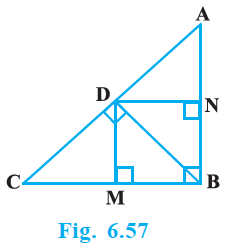
(i) $DM^2$ = DN . MC
Let us join Point D and B.
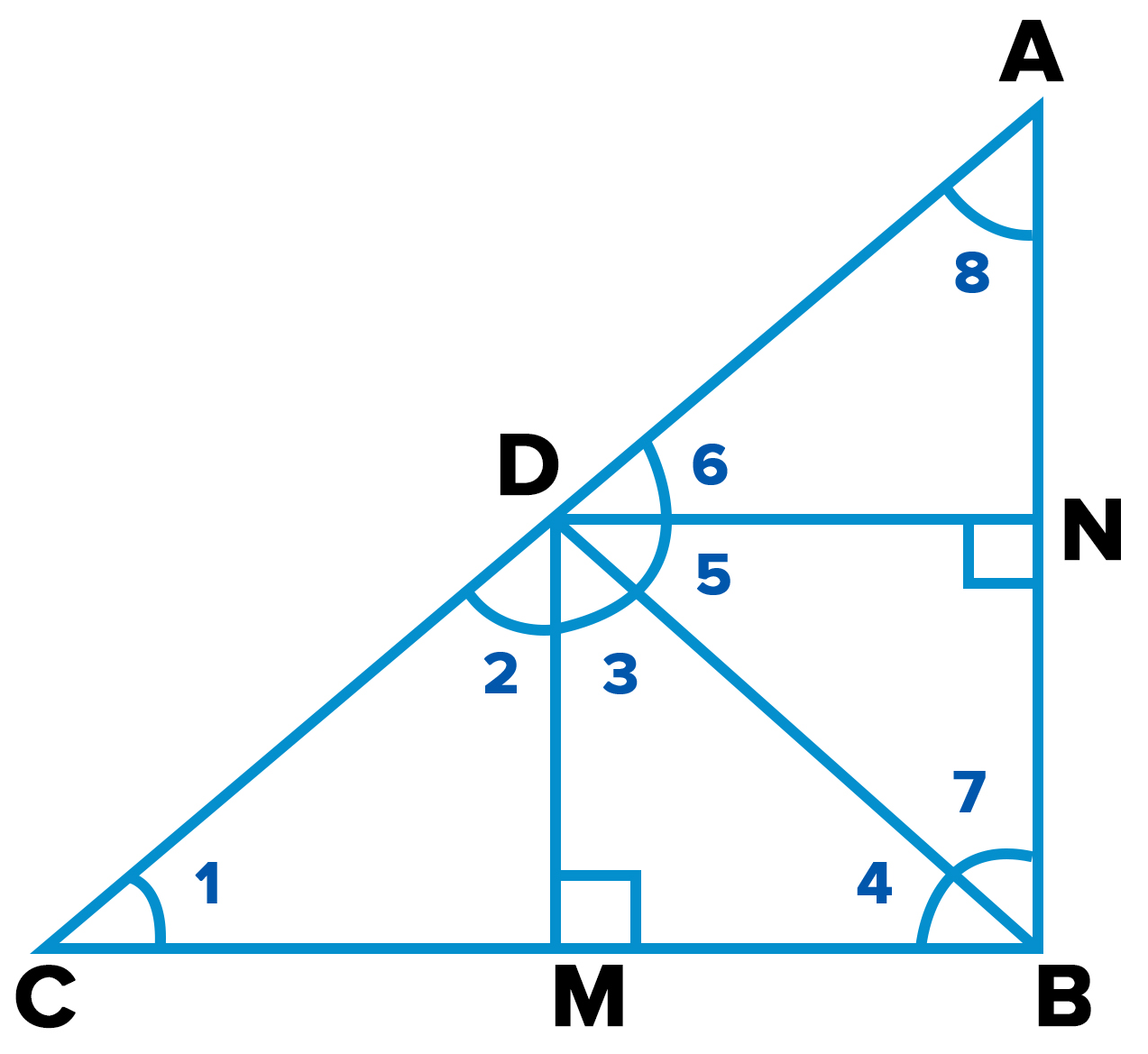
BD $\perp$ AC, DM $\perp$ BC and DN $\perp$ AB
Now from the figure we have,
DN || CB, DM || AB and $\angle B$ = 90 °
Therefore, DMBN is a rectangle.
So, DN = MB and DM = NB
The given condition which we have to prove, is when D is the foot of the perpendicular drawn from B to AC.
$\angle CDB = 90°$ ⇒ $\angle 2 + \angle 3$ = 90°……………………. (i)
In ∆CDM, $\angle 1 + \angle 2 + \angle DMC$ = 180°
$\angle 1 + \angle 2 = 90°$ …………………………………….. (ii)
In ∆DMB, $\angle 3 + \angle DMB + \angle 4 = 180°$
$\angle 3 + \angle 4 = 90°$ …………………………………….. (iii)
From equation (i) and (ii), we get
$\angle 1 = \angle 3$
From equation (i) and (iii), we get
$\angle 2 = \angle 4$
In ∆DCM and ∆BDM,
$\angle 1 = \angle 3$ (Already Proved)
$\angle 2 = \angle 4$ (Already Proved)
∆DCM ∼ ∆BDM (AA similarity criterion)
$\dfrac{BM}{DM} = \dfrac{DM}{MC}$
$\dfrac{DN}{DM} = \dfrac{DM}{MC}$ (BM = DN)
$DM^2$ = DN × MC
Hence, proved.
(ii) In right triangle DBN,
$\angle 5 + \angle 7 = 90°$ ……………….. (iv)
In right triangle DAN,
$\angle 6 + \angle 8 = 90°$ ………………… (v)
D is the point in triangle, which is foot of the perpendicular drawn from B to AC.
$ \angle ADB = 90° ⇒ \angle 5 + \angle 6 = 90°$ ………….. (vi)
From equation (iv) and (vi), we get,
$\angle 6 = \angle 7$
From equation (v) and (vi), we get,
$\angle 8 = \angle 5$
In ∆DNA and ∆BND,
$\angle 6 = \angle 7$ (Already proved)
$\angle 8 = \angle 5$ (Already proved)
∆DNA ∼ ∆BND (AA similarity criterion)
$\dfrac{AN}{DN} = \dfrac{DN}{NB}$
$DN^2$ = AN × NB
$DN^2$ = AN × DM (Since, NB = DM)
Hence, proved

By applying Pythagoras Theorem in ∆ADB, we get,
$AB^2 = AD^2 + DB^2$ ……………………… (i)
Again, by applying Pythagoras Theorem in ∆ACD, we get,
$AC^2 = AD^2 + DC^2$
$AC^2 = AD^2 + (DB + BC)^2$
$AC^2 = AD^2 + DB^2 + BC^2 + 2DB × BC$
From equation (i), we can write,
$AC^2 = AB^2 + BC^2 + 2DB × BC$
Hence, proved.

By applying Pythagoras Theorem in ∆ADB, we get,
$AB^2 = AD^2 + DB^2$
We can write it as;
$AD^2 = AB^2 − DB^2$ ……………….. (i)
By applying Pythagoras Theorem in ∆ADC, we get,
$AD^2 + DC^2 = AC^2$
From equation (i),
$AB^2 − BD^2 + DC^2 = AC^2$
$AB^2 − BD^2 + (BC − BD)^2 = AC^2$
$AC^2 = AB^2 − BD^2 + BC^2 + BD2 −2BC × BD$
$AC^2 = AB^2 + BC^2 − 2BC × BD$
Hence, proved.
In Fig. 6.60, AD is a median of a triangle ABC and AM ⊥ BC. Prove that :
(i)$ AC^2 = AD^2 + BC . DM + (\dfrac{BC}{2})^2$
(ii) $AB^2 = AD^2 – BC . DM + (\dfrac{BC}{2})^2$
(iii) $AC^2 + AB^2 = 2 AD^2 + \dfrac{1}{2} BC^2$

(i) $AC^2 = AD^2 + BC . DM + (\dfrac{BC}{2})^2$
By applying Pythagoras Theorem in ∆AMD, we get,
$AM^2 + MD^2 = AD^2 $………………. (i)
Again, by applying Pythagoras Theorem in ∆AMC, we get,
$AM^2 + MC^2 = AC^2$
$AM^2 + (MD + DC)^2 = AC^2$
$(AM^2 + MD^2 ) + DC^2 + 2MD.DC = AC^2$
From equation(i), we get,
$AD^2 + DC^2 + 2MD.DC = AC^2$
Since, DC=$\dfrac{BC}{2}$, thus, we get,
$AD^2 + (\dfrac{BC}{2})^2 + 2MD.(\dfrac{BC}{2})^2 = AC^2$
$AD^2 + (\dfrac{BC}{2})^2 + 2MD × BC = AC^2$
Hence, proved.
(ii) $AB^2 = AD^2 – BC . DM + (\dfrac{BC}{2})^2$
By applying Pythagoras Theorem in ∆ABM, we get
$AB^2 = AM^2 + MB^2$
= $(AD^2 − DM^2) + MB^2$
= $(AD^2 − DM^2) + (BD − MD)^2$
= $AD^2 − DM^2 + BD^2 + MD^2 − 2BD × MD$
= $AD^2 + BD^2 − 2BD × MD$
= $AD^2 + (\dfrac{BC}{2})^2 – 2(\dfrac{BC}{2}) MD$
= $AD^2 + (\dfrac{BC}{2})^2 – BC MD$
Hence, proved.
(iii) $AC^2 + AB^2 = 2 AD^2 + \dfrac{1}{2} BC^2$
By applying Pythagoras Theorem in ∆ABM, we get,
$AM^2 + MB^2 = AB^2$ ………………….… (i)
By applying Pythagoras Theorem in ∆AMC, we get,
$AM^2 + MC^2 = AC^2$ …………………..… (ii)
Adding both the equations (i) and (ii), we get,
$2AM^2 + MB^2 + MC^2 = AB^2 + AC^2$
$2AM^2 + (BD − DM)^2 + (MD + DC)^2 = AB^2 + AC^2$
$2AM^2+BD^2 + DM^2 − 2BD.DM + MD^2 + DC^2 + 2MD.DC = AB^2 + AC^2$
$2AM^2 + 2MD^2 + BD^2 + DC^2 + 2MD (− BD + DC) = AB^2 + AC^2$
$2(AM^2+ MD^2) + (\dfrac{BC}{2})^2 + (\dfrac{BC}{2})^2 + 2MD (\dfrac{-BC}{2} + \dfrac{BC}{2})^2 = AB2 + AC^2$
$2AD^2 + \dfrac{BC^2}{2} = AB^2 + AC^2$
Let us consider, ABCD be a parallelogram. Now, draw perpendicular DE on extended side of AB, and draw a perpendicular AF meeting DC at point F.
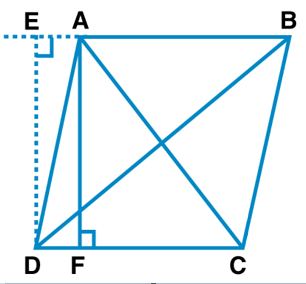
By applying Pythagoras Theorem in ∆DEA, we get,
$DE^2 + EA^2 = DA^2 $……………….… (i)
By applying Pythagoras Theorem in ∆DEB, we get,
$DE^2 + EB^2 = DB^2$
$DE^2 + (EA + AB)^2 = DB^2$
$(DE^2 + EA^2) + AB^2 + 2EA × AB = DB^2$
$DA^2 + AB^2 + 2EA × AB = DB^2$ ……………. (ii)
By applying Pythagoras Theorem in ∆ADF, we get,
$AD^2 = AF^2 + FD^2$
Again, applying Pythagoras theorem in ∆AFC, we get,
$AC^2 = AF^2 + FC^2 = AF^2 + (DC − FD)^2$
$= AF^2 + DC^2 + FD^2 − 2DC × FD$
$= (AF^2 + FD^2) + DC^2 − 2DC × FD AC^2$
$AC^2= AD^2 + DC^2 − 2DC × FD$ ………………… (iii)
Since ABCD is a parallelogram,
AB = CD ………………….…(iv)
And BC = AD ………………. (v)
In ∆DEA and ∆ADF,
$\angle DEA = \angle AFD$ (Each 90°)
$\angle EAD = \angle ADF (EA || DF)$
AD = AD (Common Angles)
∆EAD ≅ ∆FDA (AAS congruence criterion)
EA = DF ……………… (vi)
Adding equations (i) and (iii), we get,
$DA^2 + AB^2 + 2EA × AB + AD^2 + DC^2 − 2DC × FD = DB^2 + AC^2$
$DA^2 + AB^2 + AD^2 + DC^2 + 2EA × AB − 2DC × FD = DB^2 + AC^2$
From equation (iv) and (vi),
$BC^2 + AB^2 + AD^2 + DC^2 + 2EA × AB − 2AB × EA = DB^2 + AC^2$
$AB^2 + BC^2 + CD^2 + DA^2 = AC^2 + BD^2$
In Fig. 6.61, two chords AB and CD intersect each other at the point P. Prove that :
(i) Δ APC ~ Δ DPB
(ii) AP . PB = CP . DP

Firstly, let us join CB, in the given figure.
(i) In ∆APC and ∆DPB,
$\angle APC = \angle DPB$ (Vertically opposite angles)
$\angle CAP = \angle BDP$ (Angles in the same segment for chord CB)
Therefore,
∆APC ∼ ∆DPB (AA similarity criterion)
(ii) AP . PB = CP . DP
In the above, we have proved that ∆APC ∼ ∆DPB
We know that the corresponding sides of similar triangles are proportional.
$\dfrac{AP}{DP} = \dfrac{PC}{PB} = \dfrac{CA}{BD}$
$\dfrac{AP}{DP} = \dfrac{PC}{PB}$
∴AP. PB = PC. DP
Hence, proved.
In Fig. 6.62, two chords AB and CD of a circle intersect each other at the point P (when produced) outside the circle. Prove that
(i) Δ PAC ~ Δ PDB
(ii) PA . PB = PC . PD
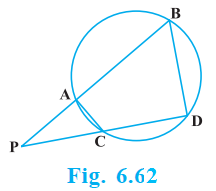
(i) In ∆PAC and ∆PDB,
$\angle P = \angle P$ (Common Angles)
As we know, exterior angle of a cyclic quadrilateral is $\angle PCA$ and $\angle PBD$ is opposite interior angle, which are both equal.
$\angle PAC = \angle PDB$
$Thus, ∆PAC ∼ ∆PDB$ (AA similarity criterion)
(ii) (ii) PA . PB = PC . PD
We have already proved above,
∆APC ∼ ∆DPB
We know that the corresponding sides of similar triangles are proportional.
Therefore,
$\dfrac{AP}{DP} = \dfrac{PC}{PB} = \dfrac{CA}{BD}$
$\dfrac{AP}{DP} = \dfrac{PC}{PB}$
AP. PB = PC. DP
In Fig. 6.63, D is a point on side BC of Δ ABC such that $\dfrac{BD}{CD} = \dfrac{AB}{AC}$ Prove that AD is the bisector of $\angle BAC$.

In the given figure, let us extend BA to P such that;
AP = AC.
Now join PC
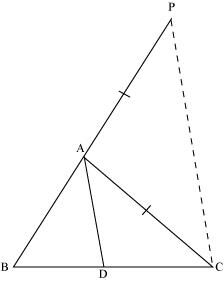
Given, $\dfrac{BD}{CD} = \dfrac{AB}{AC}$
$\dfrac{BD}{CD} = \dfrac{AP}{AC}$
By using the converse of basic proportionality theorem, we get,
AD || PC
$\angle BAD = \angle APC$ (Corresponding angles) ……………….. (i)
And, $\angle DAC = \angle ACP$ (Alternate interior angles) …….… (ii)
By the new figure, we have;
AP = AC
$\angle APC = \angle ACP$ ……………………. (iii)
On comparing equations (i), (ii), and (iii), we get,
$\angle BAD = \angle APC$
Therefore, AD is the bisector of the angle BAC.
Hence, proved.
Nazima is fly fishing in a stream. The tip of her fishing rod is 1.8 m above the surface of the water and the fly at the end of the string rests on the water 3.6 m away and 2.4 m from a point directly under the tip of the rod. Assuming that her string (from the tip of her rod to the fly) is taut, how much string does she have out (see Fig. 6.64)? If she pulls in the string at the rate of 5 cm per second, what will be the horizontal distance of the fly from her after 12 seconds?

Let us consider, AB is the height of the tip of the fishing rod from the water surface and BC is the
horizontal distance of the fly from the tip of the fishing rod. Therefore, AC is now the length of the string.
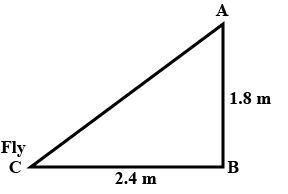
To find AC, we have to use Pythagoras theorem in ∆ABC, is such way;
$AC^2 = AB^2+ BC^2$
$AB^2 = (1.8 m)^2 + (2.4 m)^2$
$AB^2 = (3.24 + 5.76) m^2$
$AB^2 = 9.00 m^2$
AB = $\sqrt{9} m$ = 3m
Thus, the length of the string out is 3 m.
As its given, she pulls the string at the rate of 5 cm per second.
Therefore, string pulled in 12 seconds = 12 × 5 = 60 cm = 0.6 m
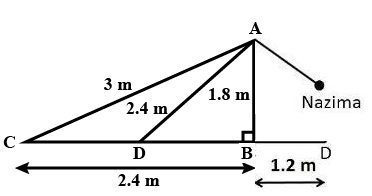
Let us say now, the fly is at point D after 12 seconds.
Length of string out after 12 seconds is AD.
AD = AC − String pulled by Nazima in 12 seconds
= (3.00 − 0.6) m
= 2.4 m
In ∆ADB, by Pythagoras Theorem,
$AB^2 + BD^2 = AD^2$
$(1.8 m)^2 + BD^2 = (2.4 m)^2$
$BD^2 = (5.76 − 3.24) m^2 = 2.52 m^2$
BD = 1.587 m
Horizontal distance of fly = BD + 1.2 m
= (1.587 + 1.2) m = 2.787 m
= 2.79 m
